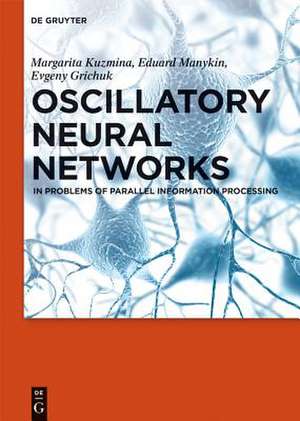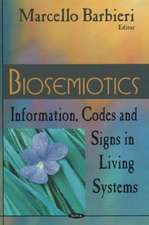Oscillatory Neural Networks: In Problems of Parallel Information Processing
Autor Margarita G. Kuzmina, Eduard A. Manykin, Evgeny S. Grichuken Limba Engleză Hardback – 31 dec 2013
Preț: 1423.13 lei
Preț vechi: 1848.22 lei
-23% Nou
272.35€ • 295.73$ • 228.77£
Carte tipărită la comandă
Livrare economică 22 aprilie-06 mai
Specificații
ISBN-10: 3110268353
Pagini: 172
Ilustrații: 45 schw.-w. Abb.
Dimensiuni: 170 x 240 x 15 mm
Greutate: 0.48 kg
Editura: De Gruyter
Colecția De Gruyter
Locul publicării:Berlin/Boston
Notă biografică
Cuprins
Contents
1. INTRODUCTION
1.1 Brain: structure and function principles.
1.2 Artificial neural networks.
1.2.1 Neuron models.
1.2.2 Feed-forward neural networks.
1.2.3 Recurrent networks.
1.3 Multilayer networks and function approximation.
1.4 Learning of neural networks.
1.4.1 Learning algorithms based on gradient descent.
1.4.2 Supervised and unsupervised learning. Relation to optimization problems.
1.4.3 Hebbian learning. Competitive learning.
1.4.4 Back-propagation learning algorithm.
1.4.5 Statistical learning theory.
1.4.6 Learning algorithms for recurrent networks. Relation to controllable dynamical systems.
1.5 Neural networks of associative memory (?attractor? networks).
1.5.1 Network memory as a controllable set of stable attractors of network dynamics. ?Extraneous? memory.
1.5.2 Memory storage capacity.
1.5.3 Problem of recall from network memory.
1.5.4 Hopfield network model. The model relation to spin systems.
1.5.5 Sparsely encoded neural networks.
1.6 Dynamical neural networks.
1.6.1 Neurons with complicated internal dynamics.
1.6.2 Neural oscillators. Oscillatory networks.
1.6.3 Oscillatory systems with chaotic dynamics. Communication via chaos synchronization.
1.7 Modern extensions of neural network paradigm.
1.7.1 Multi-agent systems.
1.7.2 Cognitive dynamical systems.
2. NEURAL, OSCILLATORY AND PHASOR NETWORKS OF ASSOCIATIVE MEMORY
2.1 Neural networks of associative memory.
2.1.1 Networks of auto-associative and hetero-associative memory.
2.1.2 Statistical macrodynamics approach for large scale associative memory networks.
2.1.3 Noise reduction by hetero-associative memory networks.
2.1.4 The analysis of recall process from memory in macrodynamical approach.
2.2 Oscillatory networks of associative memory.
2.2.1 Oscillatory and phasor networks of associative memory.
2.2.2 Features of associative memory oscillatory networks.
2.2.3 Controllable memory of phasor networks.
2.2.4 Choice of oscillatory network parameters providing the best memory characteristics.
3. OSCILLATORY NETWORKS FOR MODELING OF THE BRAIN STRUCTURE FUNCTIONS
3.1 The motivations for creation of oscillatory network models.
3.2 Types of collective dynamics for large systems of coupled oscillators.
3.2.1 Structural portrait of governing dynamical system.
3.2.2 Critical phenomena in large systems of coupled oscillators.
3.3 Oscillatory networks for modeling of olfactory and auditory brain system performance.
3.4 Overview of oscillatory network models for image processing problems.
3.4.1 Model by C.Malsburg.
3.4.2 Model LEGION by D.Wang and D.Terman.
3.4.3 Model by Z.Li.
3.4.4 Model by Y.Choe and R.Miikkulainen.
3.4.5 Model by B.Yu and L.Zhang.
3.4.6 Model by A.Labbi et al.
3.4.7 Model by R.Opara and F.Wörgötter.
3.4.8 Model by R.Borisyuk and Y.Kazanovich.
3.4.9 Model by M.B.H.Rhouma and H.Frigui.
3.4.10 Model by L.Zhao and E.Macau.
3.5 An oscillatory network model of the brain visual cortex.
3.5.1 Some known facts on the brain visual system.
3.5.2 A modified biologically motivated model of neural oscillator.
3.5.3 Architecture of oscillatory network model.
3.5.4 Principle of network coupling.
3.5.5 The model reduction to oscillatory network with two-dimensional spatial architecture.
4. DYNAMICAL METHOD OF IMAGE PROCESSING BASED ON OSCILLATORY NETWORK MODEL WITH CONTROLLABLE SYNCHRONIZATION
4.1 Problems of image segmentation. Traditional and neuromorphic methods of image analysis.
4.2 Oscillatory network model description.
4.2.1 Modified model of network oscillator
4.2.2 Network architecture.
4.2.3 Governing dynamical system.
4.2.4 Various principles of network coupling.
4.2.5 Stages of network work.
4.3 Capabilities of oscillatory network method.
4.3.1 Brightness segmentation of grey-level images.
4.3.2 Colored image segmentation.
4.3.3 Selective segmentation.
4.3.4 Problems of visual scene analysis. Sequential image fragment selection via oscillatory network approach.
4.4 Relation of developed oscillatory network method to another approaches.
4.4.1 The model relation to controllable dynamical systems.
4.4.2 The model relation to multi-agent systems.
5. OSCILLATORY NETWORKS AND PHOTON ECHO
5.1 Van der Pol oscillator in electromagnetic frequency range.
5.2 Quantum systems admissive of optical neural network implementation.
5.3 Spin echo.
5.4 Photon echo.
5.5 Optical information processing and optical processors.
6. NETWORKS OF COUPLED STOCHASTIC OSCILLATORS AND QUANTUM COMPUTING
6.1 One-way quantum computation schemes.
6.2 Quantum and classical description of polarization state of quasi monochromatic light beam.
6.3 Qubit model as a pair of coupled stochastic oscillators.
6.4 Oscillatory network for modeling of a qubit cluster.
6.5 Examples of one-qubit gate construction.
6.6 Calculation of cluster coherence and entanglement measure modification during a sequence of one-qubit measurements.
7. CONCLUSIONS. SOME FURTHER PERSPECTIVES.
Bibliography






